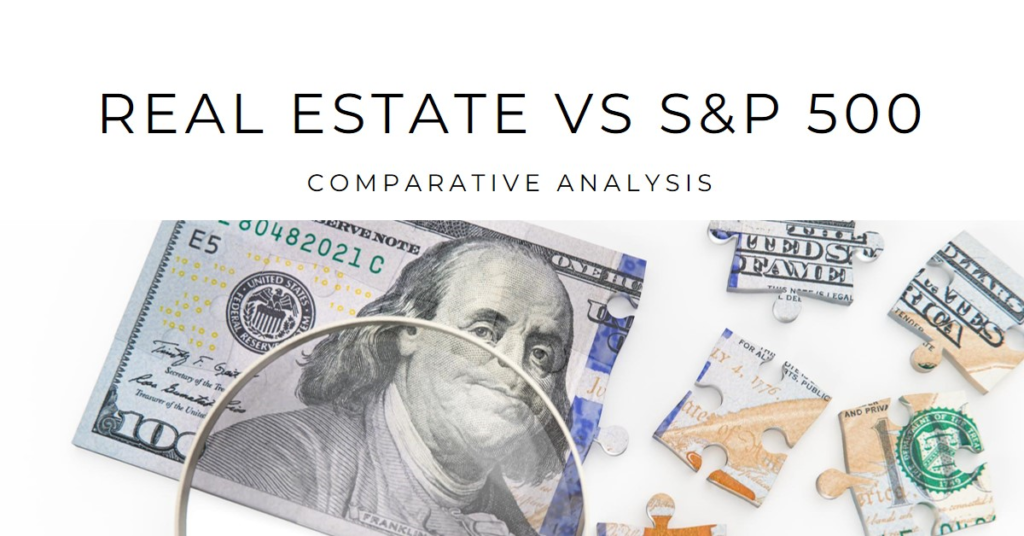
Table of Contents
Introduction
Real Estate – Investing is a cornerstone of wealth-building strategies, with numerous avenues available for individuals seeking financial growth. Two prominent options often debated among investors are real estate and the S&P 500 index. Both offer distinct advantages and drawbacks, catering to different risk appetites and investment goals. In this comparative analysis, we delve into the intricacies of real estate and the S&P 500, exploring their historical performance, risk profiles, tax implications, and long-term wealth-building potential.
Historical Performance: Real Estate Reigns Supreme
Real estate investment has long been revered for its potential to generate substantial returns over time. Historically, real estate values have appreciated steadily, providing investors with both capital appreciation and rental income. Unlike stocks, which can experience significant volatility in the short term, real estate tends to offer more stable returns, especially in prime locations with high demand.
The S&P 500, on the other hand, has a track record of impressive long-term growth, fueled by the collective performance of 500 leading companies in various industries. While the index has experienced periodic downturns, such as during market crashes or economic recessions, it has consistently rebounded and trended upward over extended periods. However, the inherent volatility of the stock market can make it a riskier investment compared to real estate, particularly for those with a lower risk tolerance.
Risk Profiles: Mitigating Volatility
One of the primary considerations for investors is risk management. Real estate often appeals to individuals seeking a more stable investment vehicle, as property values tend to be less volatile compared to stocks. Additionally, rental income from real estate properties can provide a steady cash flow stream, acting as a hedge against market downturns.
Conversely, the S&P 500 is subject to market volatility influenced by various factors, including economic conditions, geopolitical events, and corporate performance. While diversification across multiple stocks can mitigate some of this risk, investors must be prepared for the inherent fluctuations of the stock market. However, for those willing to weather the storms, the potential rewards can be substantial, with the S&P 500 historically delivering strong long-term returns.
Tax Implications: Navigating the Regulatory Landscape
Tax considerations play a crucial role in investment decisions, impacting overall returns and wealth accumulation strategies. Real estate offers several tax advantages, including depreciation deductions, mortgage interest deductions, and the ability to defer capital gains through like-kind exchanges. These tax benefits can significantly enhance the after-tax returns of real estate investments, providing investors with additional incentives to allocate capital towards property assets.
In contrast, investing in the S&P 500 exposes investors to capital gains taxes on profits realized from the sale of stocks, as well as taxes on dividends received. While certain tax-advantaged accounts, such as IRAs and 401(k)s, can mitigate some of these tax liabilities, investors must carefully consider the tax implications of their investment decisions. Additionally, legislative changes and regulatory developments can impact the tax treatment of investments, underscoring the importance of staying informed and adapting investment strategies accordingly.
Liquidity: Balancing Accessibility and Stability
Liquidity, or the ease of converting an investment into cash without significant loss of value, is another crucial factor for investors to consider. Real estate investments are typically less liquid compared to stocks, as selling a property can take time and may involve transaction costs such as agent commissions and closing fees. However, for long-term investors with a stable investment horizon, illiquidity may not pose a significant concern, especially if the property generates steady rental income.
On the other hand, the S&P 500 offers high liquidity, with investors able to buy and sell shares of the index or its constituent stocks on public exchanges with ease. This liquidity provides investors with flexibility, allowing them to quickly adjust their investment portfolios in response to changing market conditions or investment objectives. However, the downside of high liquidity is the potential for knee-jerk reactions to market fluctuations, which can lead to emotional decision-making and suboptimal investment outcomes.


Diversification: Spreading Risk Across Assets
Diversification is a fundamental principle of investment management, aimed at reducing risk by spreading investments across different asset classes and sectors. Real estate offers diversification benefits by providing a non-correlated asset to traditional stocks and bonds, helping to mitigate portfolio volatility and enhance risk-adjusted returns. Additionally, within real estate, investors can further diversify by investing in different property types, such as residential, commercial, or industrial real estate, as well as across geographic locations.
Similarly, investing in the S&P 500 provides diversification benefits by offering exposure to a broad range of industries and companies. By owning shares in 500 leading U.S. corporations spanning various sectors, investors can reduce idiosyncratic risk and benefit from the overall growth of the economy. Furthermore, the S&P 500’s global presence and diverse revenue streams contribute to its resilience in the face of domestic economic challenges, providing investors with a degree of insulation against localized market downturns.
Accessibility: Breaking Down Barriers to Entry
Accessibility refers to the ease with which investors can access and participate in a particular investment opportunity. Real estate investments traditionally required significant capital upfront, making them less accessible to individual investors compared to stocks. However, the rise of real estate investment trusts (REITs) and real estate crowdfunding platforms has democratized access to real estate investing, allowing individuals to invest in a diversified portfolio of properties with lower minimum investment requirements.
In contrast, investing in the S&P 500 is highly accessible, with investors able to purchase shares of the index through various brokerage platforms with minimal capital requirements. Additionally, the proliferation of low-cost index funds and exchange-traded funds (ETFs) tracking the S&P 500 has further simplified the investment process, enabling investors to gain exposure to the broader market with ease. This accessibility has opened up investment opportunities to a broader demographic of investors, facilitating wealth accumulation and financial inclusion.
Long-Term Wealth Building: A Marathon, Not a Sprint
Building wealth through real estate or the S&P 500 requires a long-term perspective and disciplined approach to investing. While both avenues offer the potential for significant returns over time, they require careful planning, research, and risk management to navigate successfully. Investors must align their investment strategies with their financial goals, risk tolerance, and time horizon, taking into account factors such as historical performance, risk profiles, tax implications, liquidity, diversification, and accessibility.
Ultimately, the decision to invest in real estate or the S&P 500 depends on individual circumstances, preferences, and objectives. Some investors may prefer the tangible nature of real estate and the potential for passive income, while others may favor the diversification and liquidity offered by the S&P 500. Regardless of the chosen investment avenue, the key to long-term wealth building lies in consistency, patience, and a commitment to sound investment principles.
Conclusion: Striking a Balance
In conclusion, the debate between real estate and the S&P 500 is not a binary choice but rather a spectrum of investment opportunities offering unique advantages and trade-offs. Both real estate and the stock market play essential roles in diversified investment portfolios, providing investors with avenues for wealth accumulation, risk management, and financial growth. By understanding the nuances of each asset class and carefully weighing the factors outlined in this comparative analysis, investors can make informed decisions that align with their financial objectives and pave the way for long-term prosperity.


